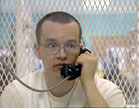
An Eye for An Eye 2004
Distributed by Filmakers Library, 124 East 40th Street, New York, NY 10016; 202-808-4980
Produced by DR TV
Directed by Frank Esman
VHS, color, 58 min.
Sr. High - Adult
Religious Studies, Law, Political Science, American Studies
Date Entered: 02/28/2006
Reviewed by Michael A. LaMagna, Reference Librarian, Cabrini College, Radnor, PAReligion in American public life is a frequent topic of discussion, especially in today’s politically charged climate. An Eye for An Eye explores the consequences of the growing influence of Christian fundamentalists in America’s political and legal systems. In the Texas town of Nacogdoches, religion permeates all aspects of the society. This understood influence was why there was little surprise when a Bible was present in the courtroom during the trial of Khristian Oliver. Oliver was convicted of the 1998 murder of Joseph Collins during a failed burglary. Even though Michael DeGuerin, Oliver’s attorney, contends jurors were reading their Bibles during the trial, it was the presence of the Bible in the jury room during sentencing that was of concern.
DeGuerin argues that juror Michael Brenneisen, a Christian fundamentalist, was quoting Bible passages as a means of influencing his fellow jurors to sentence Oliver to the death penalty. DeGuerin continues by contending the mere presence of the Bible and the use of Biblical passages in deliberating his client’s fate was unconstitutional and shows the desire of Christian fundamentalists to follow Biblical law instead of Texas law. It should be noted that an official inquiry by the court found that the Bible was not used to influence the other jurors instead it was used for reflection and solace after a tough decision. DeGuerin disagreed with the court findings and continues to fight the death penalty sentence on the grounds that it was specific Bible passages and not the finding from the trial which led to the sentence.
Unfortunately, the documentary does not explore the impact of Christian fundamentalism on America’s political and legal systems in any significant manner. Instead the documentary quickly discusses Christian fundamentalism in the United States, their influence in American politics, and how a community of Christian fundamentalists influenced a jury’s decision to impose the death penalty. This may be due to the short running time; however, the film is still unsuccessful in documenting Christian fundamentalism in the United States.
The narration of An Eye for an Eye is in Danish with subtitles and interviews in English. The sound and video quality are excellent. This documentary is recommended with reservation because of its lack of a cogent argument and the availability of other documentaries on this topic.